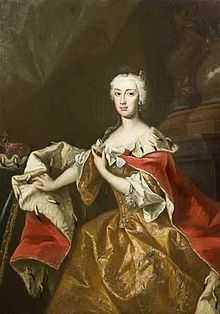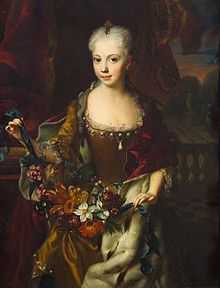Archduchess Maria Anna of Austria (governor)
| Archduchess Maria Anna | |
|---|---|
 Portrait by Johann Gottfried Auerbach | |
| Spouse | Prince Charles Alexander of Lorraine |
| House |
House of Habsburg House of Lorraine |
| Father | Charles VI, Holy Roman Emperor |
| Mother | Elisabeth Christine of Brunswick |
| Born |
18 September 1718 Hofburg Palace, Vienna, Austria |
| Died |
16 December 1744 (aged 26) Brussels, Austrian Netherlands (now Belgium) |
| Burial | Imperial Crypt, Vienna, Austria |
Archduchess Maria Anna Eleanor Wilhelmina Josepha of Austria (Vienna, 18 September 1718 – Brussels, 16 December 1744) was an Archduchess of Austria and a Princess of Lorraine, the younger sister of Empress Maria Theresa, and a Governor of the Austrian Netherlands.
Early life and background
Maria Anna was born at the Hofburg Imperial Palace in Vienna. Her birth was not well received by her father. She and her sister Maria Theresa were the only children of Charles VI, Holy Roman Emperor, and Elisabeth Christine of Brunswick-Wolfenbüttel to survive into adulthood. The two sisters were raised in the Kaiserhof in Vienna. During her youth she met her future brother in law, Francis Stephen of Lorraine and his younger brother Charles Alexander of Lorraine. The two princes were staying in Austria having a good education; their mother Élisabeth Charlotte d'Orléans was in France.
In 1725, negotiations with the Queen of Spain, Elisabeth Farnese had Maria Anna as a possible wife of Philip, Duke of Parma, who was just five. This match was supposed to smooth over relations with Spain. An alliance of Spain and Austria was signed on 30 April 1725 and thus guaranteed the Pragmatic Sanction of the Habsburgs [allowing Maria Theresa right of her father's lands being his eldest daughter], which was first declared in 1713. Based on the terms of the treaty, the Austrian Empire relinquished all claims to the Spanish throne. It also agreed that Spain would invade Gibraltar with the help of the Austrians. Despite this, the Anglo-Spanish War stopped the ambitions of Elisabeth of Parma and with the signing of the Treaty of Seville (9 November 1729) saw the abandonment of the Austro-Spanish marriage plans.
She fell in love with Charles Alexander of Lorraine, the younger brother of Maria Theresa's husband, Francis Stephen. There was considerable resistance to their marriage, not least the wish of her father for a politically more important son-in-law.
Maria Anna's husband-to-be was a half-second-cousin-once-removed, being a third generation descendant of Ferdinand III, Holy Roman Emperor, through two of Ferdinand III's children, Leopold I, Holy Roman Emperor and his half-sister Eleonora Maria of Austria.
Governor of the Austrian Netherlands
It was only after their father's death that Elizabeth Christine of Brunswick-Wolfenbüttel gave the approval for the marriage, which was concluded in St Augustine's Church (Augustinerkirche) in Vienna on 7 January 1744. The marriage was recognised by Letters Patent signed on 8 January.
Weeks after the marriage, the couple were appointed governors of the Austrian Netherlands in succession of their aunt Archduchess Maria Elisabeth of Austria, who had died in 1741. The couple left Vienna on 3 February and arrived in Westwezel, a town in the Austrian Netherlands, on 24 March where they were met by Karl Ferdinand von Königsegg-Erps. Karl Ferdinand was a member of the Supreme council of the Netherlands and had to receive Prince Charles and Maria Anna due to etiquette. Their arrival was greeted with much celebration. A ceremony had been organised for their arrival; this included a Te Deum and a collection of balls and banquets.
The couple only had two months of time together in the Netherlands, as Charles had to leave to participate in the war against Prussia, while Maria Anna, pregnant with their first child, remained in Brussels. Charles left officially on 4 May. While alone in Brussels, Maria Anna was helped by the Austrian statesman Count Wenzel Anton Kaunitz-Rietberg.
Death
In October 1744 Maria Anna went into labour and gave birth to a stilborn child; she never recovered and died on 16 December 1744 due to the difficult childbirth. Both were buried in the Imperial Crypt in Vienna. Charles Alexander never remarried.
Charles would remain the Governor until his death in 1780. He was a very popular governor and died in Brussels like his wife.
Ancestry
| Ancestors of Archduchess Maria Anna of Austria (governor) | ||||||||||||||||||||||||||||||||||||||||||||||||||||||||||||||||||||||||||||||||||||||||||||||||||||||||||||||||||||||||||||||||||||||||||||||||||||||||||||||||||||||||||||||||||||||||||||||||||||||||||||||||||||||||||||||||||||||||||||||||||||||||||||||||||||||||||||||||||||||||||||||||||||||||||||||||||||||||||||||||||||||||||||||||||||||||||||||||||||||||||||||||||||||||||||||||||||||||||||||||||||||||||||||||||||||||||||||||||||||||||||||||||||||||||||||||||||||||||||||||||||||||||||||||||||||||||||||||||
|---|---|---|---|---|---|---|---|---|---|---|---|---|---|---|---|---|---|---|---|---|---|---|---|---|---|---|---|---|---|---|---|---|---|---|---|---|---|---|---|---|---|---|---|---|---|---|---|---|---|---|---|---|---|---|---|---|---|---|---|---|---|---|---|---|---|---|---|---|---|---|---|---|---|---|---|---|---|---|---|---|---|---|---|---|---|---|---|---|---|---|---|---|---|---|---|---|---|---|---|---|---|---|---|---|---|---|---|---|---|---|---|---|---|---|---|---|---|---|---|---|---|---|---|---|---|---|---|---|---|---|---|---|---|---|---|---|---|---|---|---|---|---|---|---|---|---|---|---|---|---|---|---|---|---|---|---|---|---|---|---|---|---|---|---|---|---|---|---|---|---|---|---|---|---|---|---|---|---|---|---|---|---|---|---|---|---|---|---|---|---|---|---|---|---|---|---|---|---|---|---|---|---|---|---|---|---|---|---|---|---|---|---|---|---|---|---|---|---|---|---|---|---|---|---|---|---|---|---|---|---|---|---|---|---|---|---|---|---|---|---|---|---|---|---|---|---|---|---|---|---|---|---|---|---|---|---|---|---|---|---|---|---|---|---|---|---|---|---|---|---|---|---|---|---|---|---|---|---|---|---|---|---|---|---|---|---|---|---|---|---|---|---|---|---|---|---|---|---|---|---|---|---|---|---|---|---|---|---|---|---|---|---|---|---|---|---|---|---|---|---|---|---|---|---|---|---|---|---|---|---|---|---|---|---|---|---|---|---|---|---|---|---|---|---|---|---|---|---|---|---|---|---|---|---|---|---|---|---|---|---|---|---|---|---|---|---|---|---|---|---|---|---|---|---|---|---|---|---|---|---|---|---|---|---|---|---|---|---|---|---|---|---|---|---|---|---|---|---|---|---|---|---|---|---|---|---|---|---|---|---|---|---|---|---|---|---|---|---|---|---|---|---|---|---|---|---|---|---|---|---|---|---|---|---|---|---|---|---|---|---|---|---|---|---|---|---|---|---|---|---|---|---|---|---|---|---|---|---|---|---|---|---|---|---|---|---|---|---|---|---|---|---|---|---|---|---|---|---|---|---|---|---|---|---|---|---|---|---|---|---|---|---|---|---|---|---|---|---|---|---|---|---|---|---|---|---|---|---|---|---|---|---|---|---|
| ||||||||||||||||||||||||||||||||||||||||||||||||||||||||||||||||||||||||||||||||||||||||||||||||||||||||||||||||||||||||||||||||||||||||||||||||||||||||||||||||||||||||||||||||||||||||||||||||||||||||||||||||||||||||||||||||||||||||||||||||||||||||||||||||||||||||||||||||||||||||||||||||||||||||||||||||||||||||||||||||||||||||||||||||||||||||||||||||||||||||||||||||||||||||||||||||||||||||||||||||||||||||||||||||||||||||||||||||||||||||||||||||||||||||||||||||||||||||||||||||||||||||||||||||||||||||||||||||||
References
| Political offices | ||
|---|---|---|
| Preceded by Friedrich August von Harrach-Rohrau |
Governor of the Austrian Netherlands 1744 Served alongside: Prince Charles Alexander of Lorraine |
Succeeded by Charles Alexander of Lorraine |
| ||||||||||||||||||||||||||||||||||||||||||||||||||||||||||||||||||||||||||||||||||||||||
| ||||||||||||||||||||||||||||||||||||||||||||||||||||||||||||||||||||||||||||||||||||||

